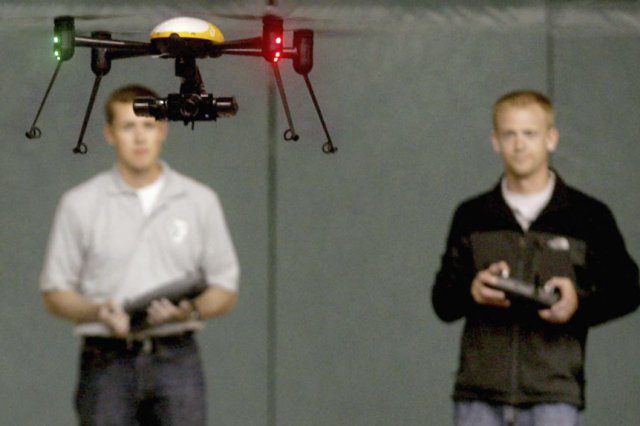
Students at John D. Odegard School of Aerospace Sciences at the University of North Dakota in Grand Forks, North Dakota, remotely pilot a drone
North Dakota is America’s leading state in drone research and testing, the Silicon Valley of drone innovation — testing, developing applications and training operators.
Four elements came together in North Dakota to give the Roughrider State a head start in the unmanned aerial systems industry (UAS) — its emptiness, its weather, its university and its UAS-friendly policies.
North Dakota’s drone industry is part of a global market, one that is expected to grow from $11.3 billion in 2015 to $140 billion in 2025, according to a report published by the Association for Unmanned Vehicle Systems International. The association estimated that the integration of current aerospace systems and UAS will have an economic impact of $82 billion in the U.S. alone over the next 10 years. Goldman Sachs estimates the worldwide drone industry could be worth $100 billion in the next two years.
In North Dakota, space is key. There are slightly more than 750,000 people in North Dakota, making it the fourth least populous state in the country, and the fourth most sparsely populated, according to a 2016 Census Bureau estimate.
“How many planes are in the air that you might run into? How many people are on the ground that you would hurt if you crash? There’re not many here in North Dakota,” said Thomas Swoyer, president of Grand Sky, the nation’s first and only drone-centric business park.
North Dakota’s weather allows for robust testing under a variety of conditions.
“We have four solid seasons,” said Nick Flom, executive director of the Northern Plains UAS test site. “Summers are over 90 degrees, and winters get below-zero temperatures. Light wind days, strong wind days — from a testing environment, that’s unique.”
At the University of North Dakota (UND), the John D. Odegard School of Aerospace Sciences began offering a bachelor of science degree in aeronautics with a major in unmanned aircraft system operations in 2009, the first U.S. school to prepare graduates to be UAS operators.
According to the UND Center for UAS Research, Education & Training, students must be “comfortable utilizing complex science, technology, engineering and mathematics principles. In addition, students must possess strong critical thinking and problem-solving skills. A commercial pilot certificate, with instrument and multiengine ratings, is required.”
Because some of the technologies involved with UAS fall under International Traffic in Arms Regulations, some of the courses are limited to students who are U.S. citizens.
“There are no exceptions to this policy,” says the center’s site.
Since 2005, the state has invested more than $38.1 million into UAS development, according to the North Dakota Department of Commerce.
Drones in action
Drone technology has the potential to benefit North Dakota’s other major industries, such as the $8 billion agriculture industry.
“There are a lot of different applications out there for use of UAS,” said Chris Theisen, a radar research meteorologist at UND who is the director of research for the Northern Plains UAS site. “From North Dakota’s standpoint, the agricultural and energy sectors are big applications. Power line inspections, pipeline inspections, monitoring vegetation, crop health — you name it.”
Usually a lot heavier and more advanced than the drones consumers find online, the ones used for these applications “replace a lot of dull, dirty and dangerous jobs, like deploying a UAS to get images for a roof inspection after a storm,” Flom said. “A UAS can do that job more efficiently.”
In agriculture, where farmers have long relied on satellite imagery and manned flights for cost-effective surveying of croplands and cattle pastures, “we believe drones can do it faster, and do it better, and do it cheaper,” Swoyer said.
First UAS business park
Established in 2015, Swoyer’s Grand Sky is the nation’s first commercial UAS business park. Located 20 miles west of Grand Forks, the 217-acre development allows commercial drone companies — big or small — to conduct UAS testing and training.
The state of North Dakota invested $17 million of public money in the Grand Sky infrastructure in the hope that it will mean high-paying jobs for residents processing data collected by drones, maintaining drones and piloting them.
A 2014 CNN report suggested that starting salaries in the industry are as high as $50 per hour, or over $100,000 per year.
“Flying those so-called unmanned aircraft systems, there’s really nothing unmanned about it,” Flom said. “You still have a pilot, and there’s a lot of additional support.”
Once aloft, the aircraft can stay airborne for 20 to 30 hours, so many pilots are used to complete one mission, which means the mission is not limited by a pilot’s fatigue or the need to eat and sleep, according to Swoyer.
Source: VOA
